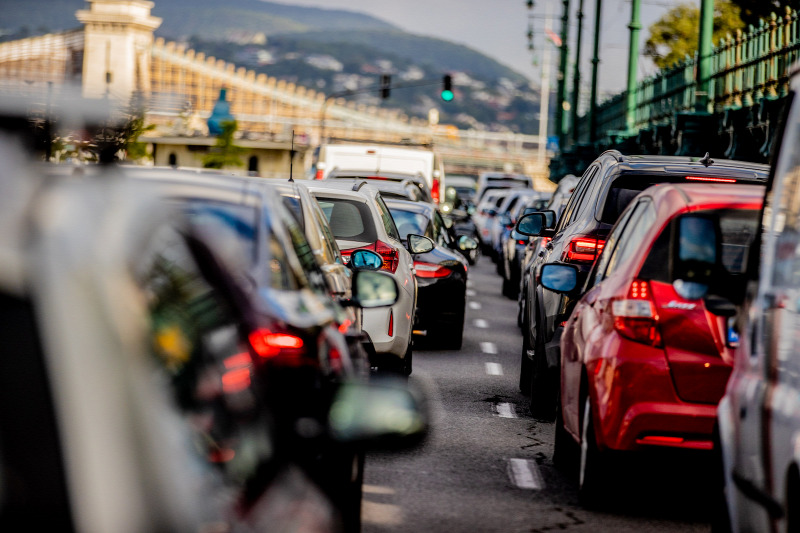Many people leave home with stomach cramps.
The piles placed on Üllői or Szent István út, which are often referred to colloquially as "Christmas stakes", referring to the mayor's erroneous traffic-related decisions, cause quite a few headaches for motorists.
As is known, the capital's management converted the former bus lane on Üllői út into a bicycle path, which is exceptionally three and a half meters wide. The lane was lined with green, flexible plastic piles, so-called deflecting bollards, which, however, do not provide adequate protection for cyclists.
Zoltán Metál, the president of the National Taxi Association, told the Magyar Nemzet in August 2023 that the installation of plastic poles will only increase the formation of traffic jams in the capital.
"If the real intention of the capital was to separate cyclists and scooter riders by narrowing the road traffic lanes and preventing all other vehicles from using them, then this can be considered a success, but
with this measure, the formation of traffic jams on the road will only be exacerbated"
- said Metál.
The paramedics also raised their voices
However, these signposts cause inconvenience not only to taxi drivers or drivers trying to do their job. Also during the summer, the National Ambulance Service spoke out in the case. In their announcement, they emphasized that the newly created bicycle lanes make it very difficult for the ambulances to move.
According to their claim, the bicycle paths created from bus lanes are too narrow for the ambulance to fit safely.
in addition, the columns can even make parking difficult at certain locations.
Lifeguards are trying to adapt to the new situation, but it is not always easy, so they asked for the understanding of motorists.
"Even the smallest streets have giga traffic jams"
Sometime after the start of school, Zsolt Wintermantel, the Budapest faction leader of the governing parties, also expressed his opinion on the subject.
The Fidesz politician drew attention to the fact that
on an average Monday in September, the traffic in downtown Budapest was 18 percent slower than usual, while on Tuesday it was 16 percent slower.
Wintermantel also added that it took two and a half minutes longer for vehicles to cover 10 kilometers, which is how much more drivers were driving - and this was also reflected in the air pollution data.
And Gábor Kubatov, the vice-president of Fidesz, took an even stronger stab at the Christmas-style city management. "I'm so bored with this two-handed, overworked mayor!
The city has stopped. Even the smallest streets have giga traffic jams…”
Kubatov wrote months ago.
"This is not good for anything other than making car traffic impossible"
We were wondering if the months that have passed since the summer have brought any changes to Budapest's roads. Has the opinion of the taxi driver community changed about transportation in the capital? That's why we asked an independent taxi driver about it.
"Traffic organization in Budapest is characterized by total confusion and chaos. The fact that the streets in the city center were closed and rerouted - including the VII. and VIII. in the district - from a taxi point of view, it resulted in
the target, which previously could be reached in two minutes, today can only be reached by driving half the district with a slight exaggeration"
said Róbert Horancsek.
It was said that during the renovation of the M3 subway, the capital's city administration created a so-called BKK lane, for example on the Múzeum körút, which is a concept that does not exist in the KRESZ.
"The official explanation - as far as Gergely Karácsony's statements can be taken - was that they were trying to facilitate the transport of metro replacement buses. I would like to note that the tabulation was already incorrect. Moving from Kálvin tér towards Astoria, the first lane was for cyclists, the second was the aforementioned BKK lane, the third was for internal traffic, and the fourth lane, which was a tram lane, was actually used by buses as well. It was lucky that neither the police nor the public space inspectors made a problem out of the fact that the taxi drivers also used the BKK lane," explained the taxi driver.
Horancsek knows that the protected cycle paths don't really have much to do with making Budapest "greener and more livable", it's just that they won various funds for this, which, one way or another, must be implemented. "This could be done normally. But
why do you have to put a bicycle lane on the sidewalk, and then give one of the car lanes to the cyclists!?
But the latest that the XIX. they also took a lane away from motorists in the district," asked the experienced driver.
The motorist stated that traffic on the Pest side, mostly in the inner districts, was made more difficult by these measures.
"If you look around Buda's Déli pályauudvar or Kelenföld, you can see that the roads are wider there, so any traffic changes will have less of an impact. As opposed to a grand tour, where two lanes were made into one"
he explained.
Many people leave home with stomach cramps
When asked how dangerous the bollards are, and what kind of damage they can do to cars, the independent taxi driver answered that after the metro replacement buses disappeared from the roads, many taxi drivers drove around Váci út out of habit, for example.
When these green piles appeared on individual streets and a car accidentally ran over them, it was not a pleasant experience"
he recalled the experiences.
The taxi driver then stated that he did not understand why the bollards had to be kept outside in winter and summer, when no one bikes on certain sections declared to be protected".
This step is not good for anything other than making car traffic impossible"
he underlined.
According to Róbert Horancsek, it would also be worthwhile to examine the psychological effect of this plugged-up city traffic on motorists and the population.
"Many motorists leave home in the morning with stomach cramps, wondering what will meet them on the roads. The endless tantrums and impossible situations often lead to situations that could easily be discussed and, what's more, dealt with with a shrug of the shoulders, turn into yelling.
he added.
Featured image: SÁNDOR CSUDAI – ORIGO












